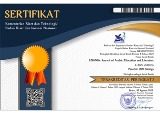Taf’īl al-Anmāṭ at-Tafā‘uliyyah fī Ta’līm al-Lugah al-‘Arabiyyah Dākhila al-Bī`ah al-Iṣṭinā’iyyah ‘alā Ḍau’i an-NaẒariyyah al-Ijtimā‘iyyah aṡ- Ṡaqafiyyah li Vygotsky
Abstract
The interaction patterns of Arabic learning can be realized in an artificial environment based on Vygotsky's socio-cultural theory. This research aims; 1. To know the interaction patterns of learning Arabic in an artificial environment. 2. To know how to activate the interaction patterns of learning Arabic in an artificial environment based on Vygotsky's socio-cultural theory. This research is a qualitative analysis descriptive study with a symbolic interactional approach. The data collected by using observation, interviews and documentation. The results of data analysed by using the Miles and Huberman analysis methods. For validating the data used triangulation method. This study finds out that, 1. The pattern of Arabic learning interaction; a. Interaction between teachers & students. b. Interaction between teachers & groups of students, c. Interaction between teacher groups & student groups. 2. There are important thing in activating the interaction pattern; a. Mediated learning. b. Ensure the regulation in children by using scaffolding techniques in zone proximal development of student (ZPD). c. Apply the micro genesis model by providing collaborative learning. d. Watch for and supervise the use of children's "inner speech" and "private speech" considering their level of cognition and age. e. Using an active system in Arabic learning.
Keywords
Full Text:
PDFReferences
Al-Busaidi, F. Y. (2019). The Socio-Cultural Factors Influencing Learners of Arabic in the Sultanate of Oman. International Education Studies, 12(8), 72–82.
Blumer, H. (1986). Symbolic Interactionism: Perspective and Method. University of California Press.
Blumer, H. (2004). George Herbert Mead and Human Conduct. Rowman Altamira.
Brieger, E., Arghode, V., & McLean, G. (2020). Connecting theory and practice: Reviewing six learning theories to inform online instruction. European Journal of Training and Development, ahead-of-print(ahead-of-print). https://doi.org/10.1108/EJTD-07-2019-0116
Clarà, M. (2013). The Concept of Situation and the Microgenesis of the Conscious Purpose in Cultural Psychology. Human Development, 56, 113–127. https://doi.org/10.1159/000346533
Daniels, H. (2018). Vygotsky: Between socio-cultural relativism and historical materialism. From a psychological to a pedagogical perspective. Cultural-Historical Psychology, 14(3). https://ora.ox.ac.uk/objects/uuid:b9b8dd5e-6eb7-4e3e-90c1-bf381de2bf21
Fabbrichesi, Rossella. (2018). The social structure of language and consciousness in George Herbert Mead. https://doi.org/Philosophy Journal. 11. 45-61. 10.21146
Fitch, K. L., & Sanders, R. E. (2004). Handbook of Language and Social Interaction. Psychology Press.
Fleming, J., & Haigh, N. J. (2018). Using sociocultural insights to enhance work-integrated learning. Higher Education, Skills and Work-Based Learning, 8(4), 395–407. https://doi.org/10.1108/HESWBL-09-2017-0071
Gillin, J. L. (1950). Cultural Sociology: By John Lewis Gillin. [and] John Philip Gillin. Macmillan.
Green, B. S. R. (1966). An Introduction to Sociology /cby Bryan S. R. Green and Edward A. Johns. Pergamon Press.
Grigoryan, T., & Babayan, N. (2018). Activity Theory In Studying Innovations: The Interconnected Phases Of Activity System.
Haythornthwaite, C. (2019). Learning, connectivity and networks. Information and Learning Sciences, 120(1/2), 19–38. https://doi.org/10.1108/ILS-06-2018-0052
Howell, E. (2018). Scaffolding multimodality: Writing process, collaboration and digital tools. English Teaching: Practice & Critique, 17(2), 132–147. https://doi.org/10.1108/ETPC-05-2017-0053
Ilmiani, A. M. (2017). تعليم مهارة القراءة في ضوء النظرية البنائية الاجتماعية لفيجوتسكي دراسة الحالةفي جامعة بالنجكارايا الإسلامية الحكومية. Al-Ta’rib : Jurnal Ilmiah Program Studi Pendidikan Bahasa Arab IAIN Palangka Raya, 5(2), 117–126. https://doi.org/10.23971/altarib.v5i2.771
Kharma, N. (1988). Lughat Ajnabiyah_Ta’limuha wa Ta’allumuha by. ’alamul ma’rifah.
Koczanowicz, L. (1994). G.H. Mead and L.S. Vygotsky on Meaning and the Self. The Journal of Speculative Philosophy.
Mas’ud, M. (2017). Konsep Life Skills dalam Pembelajaran Bahasa Arab di Madrasah. LISANIA: Journal of Arabic Education and Literature, 1(2), 20–39. https://doi.org/10.18326/lisania.v1i2.20-39
Miles, M. B., Huberman, A. M., & Saldana, J. (2014). Qualitative Data Analysis. SAGE.
Mitchell, R., Myles, F., & Marsden, E. (2013). Second Language Learning Theories. Routledge.
Mutiah, D. (2015). Psikologi Bermain Anak Usia Dini. Kencana.
Myles, S. of M. L. F., Mitchell, R., & Myles, F. (1998). Second Language Learning Theories. Arnold.
Nurkholida, E. (2018). Developing Authentic Material Of Listening On Higher Education Based On Constructive Learning Of Jean Piaget And Vygotsky Theory. Okara: Jurnal Bahasa Dan Sastra, 12(1), 59–74. https://doi.org/10.19105/ojbs.v12i1.1762
Rahardjo, M. (2001, October 27). Bahasa dan peradaban: Sebuah tinjauan filsafat [Other]. Rapat Terbuka Senat STAIN Malang dalam Rangka Wisuda Lulusan Diploma 2, Sarjana (S1), dan Pascasarjana (S2), Sekolah Tinggi Agama Islam Negeri Malang. http://repository.uin-malang.ac.id/1530/
Silalahi, R. (2019). Understanding Vygotsky’s Zone Of Proximal Development For Learning. Polyglot: Jurnal Ilmiah, 15, 169. https://doi.org/10.19166/pji.v15i2.1544
Sudaryono. (2016). Metode Penelitian Pendidikan. Prenada Media.
Suwendra, D. D. I. W. S., S. Pd. (2018). Metodologi Penelitian Kualitatif dalam Ilmu Sosial, Pendidikan, Kebudayaan dan Keagamaan. Nilacakra.
Vasileva, O., & Balyasnikova, N. (2019). (Re)Introducing Vygotsky’s Thought: From Historical Overview to Contemporary Psychology. Frontiers in Psychology, 10. https://doi.org/10.3389/fpsyg.2019.01515
Vygotsky, L. S. (1986). Thought and Language. MIT Press.
Vygotsky, L. S., Luria, A. R., & Knox, J. E. (2013). Studies on the History of Behavior: Ape, Primitive, and Child. Psychology Press.
Yasnitsky, A. (2018). Vygotsky: An Intellectual Biography. Routledge.
Yusuf, P. D. A. M. Y. (2016). Metode Penelitian Kuantitatif, Kualitatif & Penelitian Gabungan. Prenada Media.
Zavershneva, E., & van der Veer, R. (2018). Lev Vygotsky. https://doi.org/10.1007/978-3-319-16999-6_2391-1
Az-Zuhairi, . (2017).= Education Research Methods. Al Manhal.
DOI: https://doi.org/10.18326/lisania.v4i2.196-216
Refbacks
- There are currently no refbacks.
Copyright (c) 2020 LISANIA: Journal of Arabic Education and Literature
View My Stats







